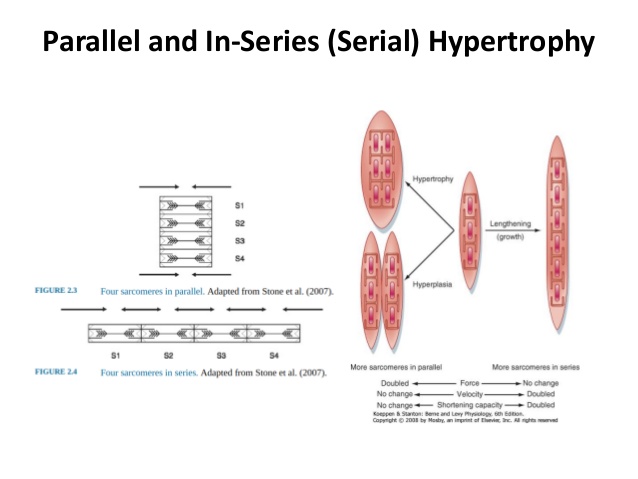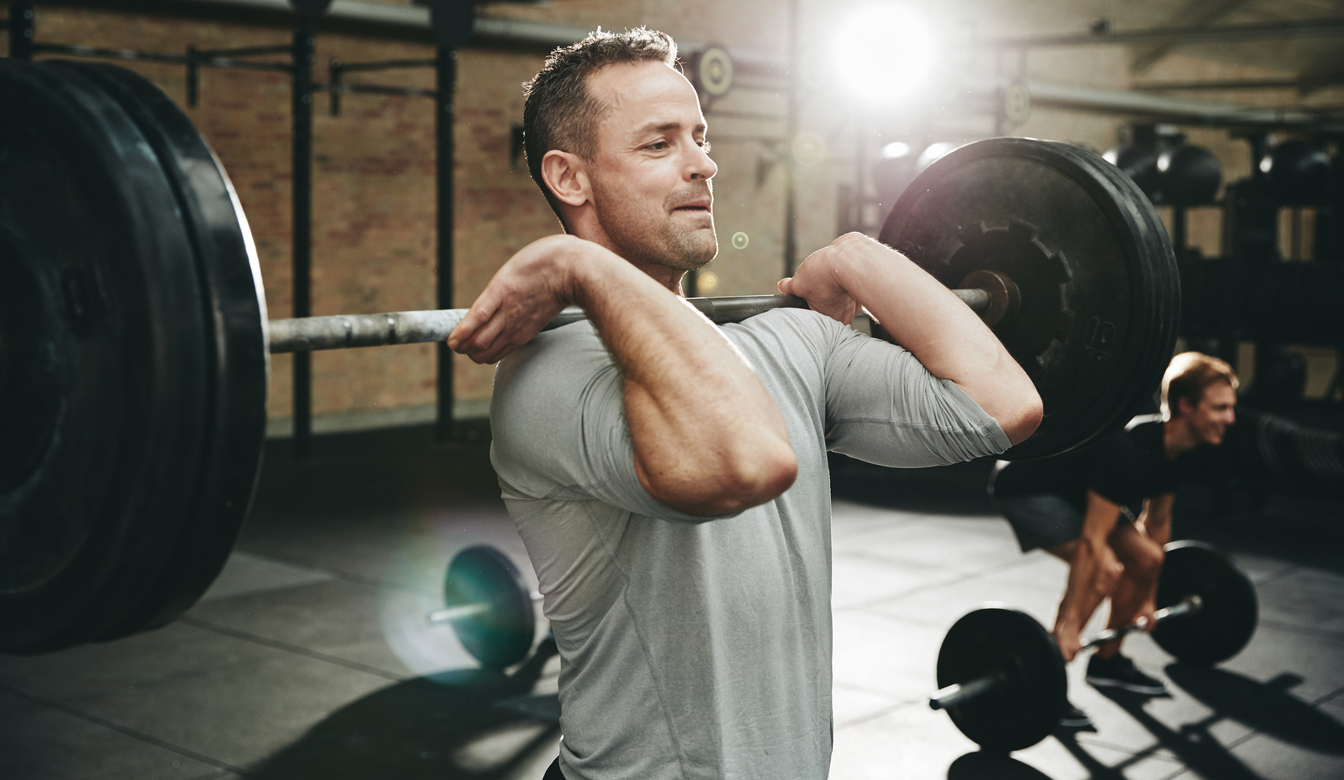In the world of fitness education, the theory (physiology) and application (training) in pursuit of muscular hypertrophy (gaining muscle mass) has been established for some 50 years in the annals of research. Paul Edmondson shares how to maximise both health and fitness using hypertrophy training.
Let’s take a look at the traditional stance on muscular hypertrophy training. Variables and training parameters currently centre on:
- rep range – six to 12 (to failure)
- three to six sets of an exercise
- split routines (dividing the body into constituent parts to train more volume/intensity for target muscles)
- compound over isolation exercises – bigger exercises that challenge more muscles secrete more anabolic hormones that fortify muscle tissue
- around 40-70secs total ‘time-under-tension’ – the duration time for which a working set lasts, which evidence points to being an optimal environment to stimulate hypertrophic responses.1
What is hypertrophy?
Muscular hypertrophy is an increase in the size of muscle tissue. During the hypertrophic process, contractile elements enlarge and the extracellular matrix expands to support growth. Growth occurs by adding sarcomeres (compartments along the length of a muscle that houses the contractile proteins actin and myosin), increasing non-contractile elements and sarcoplasmic fluid, and bolstering satellite cell activity. This can happen two ways: ‘in series’ and ‘in parallel’.

Traditional linear load training ‘triggers’ an ‘in parallel’ adaptation, whereby the muscle grows in its circumference/width. This is the most common form of hypertrophy that dominates most hypertrophy programmes across the world, and has done for decades now, brought about by the variables discussed above.2
‘In series’ hypertrophy, whereby the muscle grows in length via an increasing of sarcomeres, is the adaptation when odd-position, 3D multiplanar training is introduced. Research points to ‘loaded stretch’ training, AKA Loaded Movement Training, mechanically distorting ‘titin’ fibres that run parallel to myofibrils and bolstering the length in the sarcomeres. Long and strong = functional hypertrophy.3
So already we have two different mechanisms of hypertrophy and how they are stimulated; from an aesthetic viewpoint, hopefully you can see the unique advantage to having BOTH linear load traditional training (squats, deadlifts, bench presses, etc.) and 3D load training periodised within your weekly/monthly training programmes – to fortify maximal length and width of the muscle’s façade.
What is hyperplasia?
Hyperplasia is when the fibre content within a given muscle increases – where individual myofibrils split, divide and multiply, making greater overall numbers of fibres within the sarcomeres. Once considered a distant theorisation, it has now been shown to be possible in animals and humans – quite different from the mechanisms of hypertrophy but equally valid, and essential in a person’s quest to sculpt a muscular/aesthetic physique.
The only method of training that has evidence to yield such benefits of hyperplasia is that of ‘active range holds’, a form of stretch training, and Loaded Movement Training.4
Active range hold stretching takes place where a stretch is held within a state of tension (not relaxation, which is how most stretch training is executed). The muscle exhibits tensile force through partial bodyweight, or an external force applied, for around 30% of effort. Applying active tension is ‘key’ to unlocking this potential and I personally love the TRX suspension trainer, which gives a great way to find, then hold, a stretch and then slowly begin to apply force through active tension holds to one’s own capacity, to stimulate growth of new fibrils through prolonged mechanical tension.
Let’s now introduce three approaches to your training to maximise your hypertrophic gains!
1. Adopting intra-set rest training alongside your traditional linear load days
This is where active range holds (stretches) take place for 30-90secs: start with 30secs and progress towards longer holds, in between working sets and in between exercises. Think of it as performing your working sets and then super setting with high active tension holds/stretches set after set, for all trained muscles in the workout/programme. This methodology can be thought of as a new training system but with the specific focus of triggering both hypertrophy and hyperplasia in/around trained myofibrils5.
Example: bench press 10 reps to failure, rest 30secs, initiate active range hold stretch for 60secs (30% effort), rest 30secs, repeat as many sets as desired. Do the same for every trained muscle throughout the week.
2. Loaded Movement Training (LMT)
Whole-body, task-orientated movement trained with external mass, moving three dimensionally to fortify ‘long and strong’ muscle tissue through lengthening and strengthening of titin proteins; this adds length to sarcomeres, giving muscles the long, aesthetic, ‘fit’ look. Coupled with the hypertrophic gains, LMT has also been shown to increase numbers of protein strands – hyperplasia adaptation – (up to 58% more) in trained muscles through increased time in a ‘high mechanical tension’ environment. Talking of high mechanical tension environments, an adage can be laid to bed (see below).6
3. Low load – high rep training
It’s not necessarily new, in fact far from it, but any kind of resistance training that’s subjected to high repetitions to failure (in the 12-25 range) – usually considered muscular endurance range – has been shown to stimulate high-threshold motor units (HTMUs). HTMUs typically ‘switch-on or contribute’ to high-threshold/lactate-style tasks. Their respective muscle fibres are now recruited for the modulation of muscle mass – more muscles recruited, more hypertrophy possibilities. This high mechanical tension environment also yields inflammatory processes whereby hypertrophy is realised.
The inflammatory processes kick-started by high mechanical tension environments increase the body’s production of lactic acid via a high-intensity training effect; the lactic acid ‘bathing’ of muscles is coupled with anabolic hormonal secretion, which are catalysts to building muscle tissue and diminishing body fat, and are where gains of hypertrophy are initiated.
These anabolic hormones are testosterone, human growth hormone (HgH), insulin-like-growth-factor-1 (IGF-1) and the lesser known mTOR (mammalian target of rapamycin). These all modulate the growth factors in human muscle proteins and all build muscle and burn body fat – these are the ‘keys’ to unlocking aesthetic potential.7
Who should partake in the pursuit of hypertrophy?
In a nutshell, everybody!
Increases in muscle mass assist with the following:
- Improve body composition – increase lean muscle and burn body fat – so you look and feel better.
- Boost immune system function – because of increased glutamine production (amino acid that governs immune function) defending against colds, flu and COVID-19 signs/symptoms.8
- Protect, stabilise and assist in dynamic mobility around joints/connective tissue.
- High rep/low load days are great for ‘the engine’ – increasing capillarisation and mitochondrial density. The more of these you have, the longer you’ll live. Period.
- LMT – enhances ALL tissue integrity (skin, muscle, nerves and fascia), meaning more elasticity, strength, hydration and resilience, as well as dynamic functional mobility in the articular elements of the body preventing osteoarthritis and osteoporosis.
- Production of endocannabinoids (enzyme particles found in marijuana; also, we humans have these built into our muscle tissue) released into the blood, elevating euphoric feeling, cognitive function, mood and self-esteem.
You’ve been looking out for ‘that programme’ for some time now that maximises HEALTH and FITNESS, as well as improving the way you look and feel. Look no further: you’ve just found it!
Author Bio

Paul Edmondson is a dedicated leader within the fitness industry, having worked with, and for some of the leading pioneers and biggest brands in the world both nationally and globally. Paul has presented in 24 countries, over 5 continents on behalf of Gray Institute, ViPR, TRX, Anatomy Trains, Trigger Point, SKLZ, institute of Motion and at the IDEA World conference. His thought-provoking sessions are designed to bridge the gap between the traditional and new sciences to better equip trainers to serve their unique and individual clients. Paul takes pride in delivering complex content in a simplified and application specific manner that is perfect for trainers wanting to learn more, and is determined to drive forward those he works with to help them become “better versions of themselves”
Resources and references:
1 Tudor Bompa (Periodization)
2 Brad Schoenfeld (Science and development of Muscle Hypertrophy)
3 Chris Beardsley (Personal conversations)
4 Brad Schoenfeld (Science and development of Muscle Hypertrophy)
5 Brad Schoenfeld (Science and development of Muscle Hypertrophy)
6 Brad Schoenfeld (Science and development of muscle hypertrophy)
7 Institute of motion (metabolic flexibility)
8 Charles Poloquin (Poloquin group)







